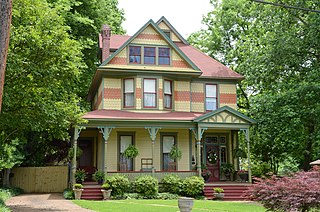
Independence County is a county located in the U.S. state of Arkansas. As of the 2010 census, the population was 36,647. The county seat is Batesville. Independence County is Arkansas's ninth county, formed on October 20, 1820, from a portion of Lawrence County and named in commemoration of the Declaration of Independence. It is an alcohol prohibition or dry county.

The Shady Grove School is a historic school building on Arkansas Highway 94 near Pea Ridge, Arkansas. It is a single-story wood frame structure, with a hip roof and a concrete foundation. A gable-roofed cupola provides ventilation to the roof, which is also pierced by a brick chimney. The main facade consists of a double door flanked by sash windows, and the long sides of the building have banks of sash windows. Built c. 1922, the building is a well-preserved representative of a period school building.

Sardis Methodist Church is a historic church northeast of Pine Grove off Arkansas Highway 128 in Sparkman, Arkansas. The single-story wood frame church was built c. 1895, and is a well-preserved example of a vernacular rural church in Dallas County. The building features a cross-gable roof, an unusual configuration not seen on most of the county's rural churches, and has a pyramid-roofed tower with open belfry at its southwest corner.

Holly Grove Presbyterian Church is a historic church at 244 East 2nd Street in Holly Grove, Arkansas. It is a single-story wood frame building, with a gable-roofed rectangular sanctuary, a square tower off to one side, and a Sunday School addition to the rear. The exterior, originally clad in board-and-batten siding, is now finished in metal siding that closely resembles a c. 1900 residing. It exhibits a combination of Greek Revival and Gothic Revival features. It was built in 1881 for a congregation established in 1839, and was its second sanctuary, replacing one destroyed by fire in 1871.

The Oak Grove Rosenwald School is a historic school building on Oak Grove Road in Oak Grove, a small settlement in southeastern Sevier County, Arkansas. It is a single-story wood-frame structure, built in 1926 with financial assistance from the Rosenwald Fund. It has two classrooms, and is based on a standard plan developed by Samuel Smith, an agent for the Rosenwald Fund, for this type of small community school. It was probably used for the education of local African Americans until the state's schools were integrated, and is the only surviving Rosenwald school in the county.

The Orr School is a historic school building at 831 Laurel Street in Texarkana, Arkansas. It is a single story wood frame structure, with a hip roof that has exposed rafters. It is clad in white shiplap siding. The interior has a long, narrow hallway dividing classrooms on either side. The school was built c. 1880, and is the only surviving building in Texarkana associated with the life of the noted African-American composer Scott Joplin (1868-1917), the "father of American Ragtime". The building was originally two stories in height, but was reduced to one in 1920, when then hip roof and some of its Craftsman-style window treatment was added. It was purchased from the city by the City Federation of Women's Clubs in 1958.

The Cedar Grove School #81 is a historic school building on the west side of Arkansas Highway 115 in the small community of Brockett, Arkansas, about 5 miles (8.0 km) north of Pocahontas. It is a wood frame one-room schoolhouse, 23 by 41 feet in size, with a gable roof and a concrete foundation. It was built in 1938, replacing another building destroyed by a tornado, and served as a district school until 1948, when the district was consolidated into the Pocahontas schools. The building has been used since then by the Brockett Home Extension Club as a community center.
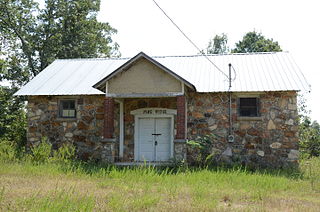
The Pine Ridge School Building is a historic school building in rural Izard County, Arkansas. It is a single-story fieldstone structure, located on the south side of Pine Ridge Road about 0.5 miles (0.80 km) west of Brockwell. It was built c. 1920, fashioned out of uncoursed native sandstone with grapevine mortar joints. A central gable-roofed entrance portico extends from the center of the building's north facade. It is a fine local example of an early 20th-century one-room school building.
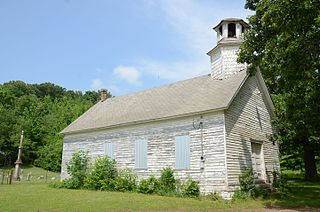
The Shady Grove Delmar Church and School is a historic church and school building in rural Carroll County, Arkansas, US. The building, a single story wood frame structure with a gable roof, weatherboard siding, and a distinctive hexagonal tower with belfry and cupola. The building was built c. 1880 to provide a space for both religious services and a district school. It is a virtually unaltered example of the type, which was once common in rural Arkansas. The building is located on County Road 933, about 1.4 miles (2.3 km) west of the hamlet of Delmar, on the north side of Osage Creek.

The Hulsey Bend School is a historic one-room schoolhouse building in rural southeastern Independence County, Arkansas. It is located east of Oil Trough on Freeze Bend Road, about 0.7 miles (1.1 km) north of Arkansas Highway 14. It is a single-story wood frame structure, with a gable roof and weatherboard siding. The gabled ends each have an entrance, while the sides each have three windows. Built c. 1900, it is the best-preserved district schoolhouse in the Oil Trough area and believed to be the last in the county; it was used as a school until 1947.

The Jamestown School is a historic school building in rural central western Independence County, Arkansas. It is located in the hamlet of Jamestown, just north of Arkansas Highway 230 at the junction of Race Street and Snapp Lane. It is a single-story wood frame structure, with a T-shaped plan, cross-gable roof, novelty siding, and stone foundation. It is stylistically Craftsman, mostly in plan and layout of windows. It was built in 1926, and was used as a county school until 1949.
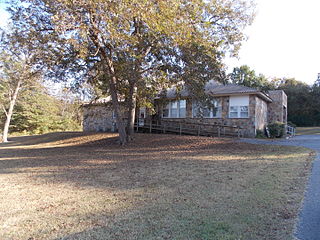
The Moorefield School is a historic former school building on Ham Street in Moorefield, Arkansas. It is a broad rectangular single-story building built out of fieldstone, with a gable-on-hip roof that has exposed rafter ends in the Craftsman style. Entrances on the north and west sides are set under parapeted square porches. The school was built in 1936–37 with funding from the National Youth Administration and served the community as a school until 1947. It now houses the Rehoboth Baptist Church.
The Pfeiffer House is a historic house on United States Route 167 in Pfeiffer, Arkansas. Located on the west side the highway, north of its junction with Pfeiffer Road, it is a single-story stone structure with an extreme vernacular interpretation of American Craftsman styling. It has a hip roof with long eaves, supported by a series of elongated knee braces, and its corners and windows are irregularly quoined with lighter-colored Batesville "marble", which constitutes the building's principal building material. The house was built in 1924 by Joseph Pfeiffer, a stonecutter and owner of the Pfeiffer Quarry, which provided the stone for the Arkansas State Capitol and is credited for doing some of that building's elaborate stonework.

The Walnut Grove Cemetery is a historic cemetery in rural Independence County, Arkansas, United States, on Walden Road, just north of Arkansas Highway 25, northwest of Cord. Established in 1840, it is one of the oldest cemeteries in the area, set on what was once the only major roadway through the region. It is the only significant surviving element of the community of Walnut Grove, which was located at a locally important crossroads in the 19th century.

The Holly Grove School was a historic school building in rural White County, Arkansas. It was located northwest of Bald Knob, north of the junction of Stanley and Honeysuckle Roads. It was a single story Craftsman-style structure, fashioned out of local fieldstone and brick in 1939 by a crew of the National Youth Administration, a Depression-era jobs program. It was one of the better examples of NYA construction.

The Oak Grove School is a historic school building in rural eastern Grant County, Arkansas. It is located on the south side of United States Route 270, about 6 miles (9.7 km) east of Sheridan, and is now home to the Center Grove United Methodist Church. It is a single-story wood frame structure, with a hip roof and novelty siding. It was built in 1938 with funding from the Works Progress Administration, and originally housed four classrooms. It was used as a school until 1950, and has served as the church since then.
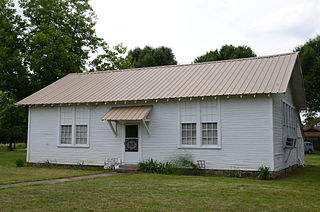
The Liberty School Cafeteria is a historic school building in rural Faulkner County, Arkansas. It is located on the west side of Arkansas Highway 36, about 0.25 miles (0.40 km) north of its junction with United States Route 64, about midway between Conway and Vilonia. It is a modest single-story wood frame structure, with a gabled roof that has exposed rafter ends in the American craftsman style. It was built in 1935 with funding support from the Works Progress Administration, and originally housed classrooms for science, agriculture and math, as part of a consolidated regional primary school. In the 1940s it was converted into a cafeteria. The school district was further consolidated with Vilonia in the 1950s and 1960s, when this building's school function ceased. The grounds are now used for a flea market.

The Solomon Grove Smith–Hughes Building is a historic community building on Solomon Grove Road in Twin Groves, Arkansas. It is a single-story stone structure, built out of locally quarried stone and covered by a gable-on-hip roof. It was built in 1938 with funding support form the Works Progress Administration, and first served as a school. It was built by the African-American mason Silas Owens Sr. on land he sold to the city in 1937. It now houses a library.

The Liberty Schoolhouse, also known as the Mt. Grove School, is a historic schoolhouse in a remote part of Ozark-St. Francis National Forest in Logan County, Arkansas. It is east of Corley, Arkansas, near the junction of Valentine Spring and Copper Spring Roads. It is a single-story vernacular wood-frame structure, with a gabled roof, weatherboard siding, and a foundation of concrete block piers. It was built in 1897, and was used by the community as both a school and church. It served as a school until 1944, and also hosted civic meetings and social events.

The Prairie Grove Commercial Historic District encompasses part of the historic commercial downtown area of Prairie Grove, Arkansas. It extends for about 1-1/2 blocks on the south side of East Buchanan Street, from Mock Street to an alley east of Neal Street. The buildings on this side of the street more mostly built in the late 19th and early 20th centuries, and are good examples of brick and stone commercial architecture of the period. The district also includes a small portion of Mock Park, and two buildings constructed in the 1960s.



















